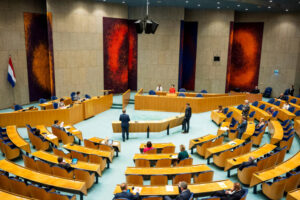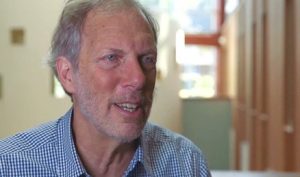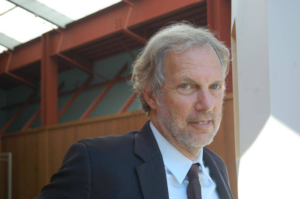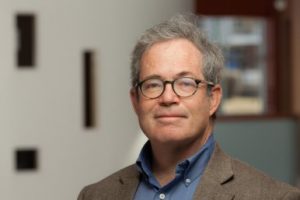Religiously Based Political Parties In Democracies. The Case Of The Netherlands
Since the Netherlands became a full-fledged democracy in 1848 political parties of diverse ideological backgrounds competed for the vote of the electorate, be they Christian parties, liberal parties, socialist parties, and more recently populist parties. Religions claim that their values are God given and therefore immutable. In a democracy with several ideological streams seeking representation in Parliament, it is in most cases difficult if not impossible for one party to obtain more than 50% of the votes, and that poses a challenge to those religious parties that claim to base themselves on ‘universal’ God given values[i]. They have either the choice to stay in an oppositional role in Parliament and continue giving voice to their opinions. The other option is that they seek alliances with parties to which they resemble in order to form a government. But that last strategy implies that they must be prepared to reach compromises with other parties, thus possibly renouncing in cases the ‘eternal’ values the parties claim to represent. The preparedness to compromise goes by the way as well for secular parties that claim ‘universal truths’, but the difference between religious parties and secular parties is of course that religious parties claim that their values are of a higher nature, i.e. coming from God.
This article treats how the mechanisms of compromise work in the Dutch political system, focusing in particular on religious, in the Dutch case, mostly Christian political parties that enter coalition governments with other -often- secular parties. The article first presents a description of the Dutch political system and its Constitution, and the coming to being of the Dutch Nation State. Then it goes into the subject of how governments are formed in the Kingdom. Following, the article treats the specific case of how the 2017 Dutch coalition government was formed and how it treated the highly sensitive issue of euthanasia law in its coalition agreement, where an orthodox Christian party and a secular party had to come to terms on this issue. I use this case as to show how a religious party can function in a democracy with, in the Dutch case, mostly non-religious parties.
1 The Dutch Political System and Constitution
The Netherlands form since 1848 a constitutional Monarchy in which the King functions as a symbol of the unity of the people of the Netherlands but he does not hold any political power. The government, consisting of the Prime Minister and the Ministers, exercise power and are held responsible for their acts in Parliament. The Dutch Parliament consists of two Chambers. The Second Chamber is elected directly by the people and consists of 150 seats. The electoral system is of a representative nature, implying that the total number of valid votes in elections is divided by 150. The Netherlands does not have constituencies like the United Kingdom and France have. The First Chamber consists of 75 seats and is elected indirectly by the representatives of the 12 provinces the country counts. The country has a tradition that in elections no party ever obtained an absolute majority in Parliament and therefore coalition governments always ruled the country[ii].
The first article of the Dutch Constitution reads as follows[iii]:
‘All persons in the Netherlands shall be treated equally in equal circumstances. Discrimination on the grounds of religion, belief, political opinion, race or sex or on any other grounds whatsoever shall not be permitted’.
This first article stipulates that all persons that live in the Netherlands are to be treated equally in equal circumstances. The fact that one is a man or a woman, that a person has Dutch roots or German, Chinese or any other root, that a person has conservative political opinions or progressive opinions, that a person is heterosexual, homosexual or transgender and that a person is a Christian, a Jew, a Muslim or an atheist, does not make a difference in their treatment.
Article 6 of the Constitution concerns the freedom of religion or belief and it is formulated as follows, in two parts[iv]:
– Everyone shall have the right to profess freely his religion or belief, either individually or in community with others, without prejudice to his responsibility under the law.
– Rules concerning the exercise of this right other than in buildings and enclosed places may be laid down by Act of Parliament for the protection of health, in the interest of traffic and to combat or prevent disorders.
Interesting in article 6 is that it mentions not only the right to profess freely one’s religion, but also one’s conviction (my italics). Conviction explicitly refers to non-religious beliefs, not necessarily religious ones. So, people with religious and non-religious, or secular, convictions have the right to profess these in Dutch society.
The present Constitution of the Netherlands is based on its first draft that dates to 1848.
2 The genesis of the Dutch nation state
In 1789 the French revolution took place. The world would soon learn to know the new French regime based as it was on the principles of the Enlightenment. The French revolution would be the cradle of modern democracy and France would soon spread the revolution over Europe. French revolutionary troops occupied the Netherlands in 1795 causing the ruling prince Willem V to flee to Germany[v]. In the Netherlands there were at that time already citizens, referred to as ‘patriots’, who supported the principles of the Enlightenment, opposing the prince and the nobles that wanted to stick to the old rule. The Netherlands knew until 1795 a decentralized government in which the several provinces enjoyed great autonomy. With the French and patriots taking over, the country formed a National Assembly that set itself in making a Constitution based on the principles of the French Revolution: Liberty, Equality and Fraternity. This was though no so simple. The Netherlands was until 1795 basically a country where the Protestant church was dominant and where the two other religious denominations, i.e. the Catholics and the Jews, were second rang citizens that never got positions in the local and provincial boards. The 80-year war against Spain (from 1568-1648) led to throwing of the yoke of the Spanish (and Catholic) occupier and although the Dutch Republic was at that time a relatively tolerant power in Europe when it comes to religious freedom, the Protestant church was dominant, and all other religions were subordinate to it. And now the new State had to develop a constitution that would guarantee liberty and equality to all citizens, including the Catholics and the Jews. It took a long time before the debates in the National Assembly led to a Constitution and laws that foresaw in the principle of equality for all but in the end, it managed to do so[vi][vii].
The French occupation ended in 1813. The French troops left the country to assist Emperor Napoleon in the last battles he fought and which he ultimately lost. The country looked back at 18 years of French presence. From 1806-1810 Napoleon had changed the country into a Kingdom with his own brother Louis Napoleon on the throne. Louis Napoleon was not a bad king. He tried to develop the country as much as possible in the spirit of the French revolutionary principles. When the French left, the country had a constitution that foresaw in the equality of all its citizens. The paradox of the period after the French left is that the Dutch nation state remained built on the principles of Enlightenment. There were voices in society that called for a retour to the situation before 1795 but the enlightenment ideology was stronger than the conservative forces. The Netherlands kept a constitution based on the enlightenment. The son of the late prince Willem V came back to the country to become the future King Willem I, and he as well submitted to the new order. The country wet itself in developing as a modern nation state, centrally governed, investing a lot in infrastructure and education.
In 1848 a reform of the constitution took place making the country more democratic than before. One of the major changes was that the King lost the political power he still had. A government that was democratically elected without any interference of a hereditary sovereign should rule the country. The King protested but accepted his limited role as head of state only. The principles of liberty, equality and fraternity had in the end led to a society, which not only legally foresaw in equal chances for all, but also in reality[viii].
Noam Chomsky And Robert Pollin: Green New Deal Is Essential For Human Survival
 This story is part of Covering Climate Now, a global journalism collaboration strengthening coverage of the climate story.
This story is part of Covering Climate Now, a global journalism collaboration strengthening coverage of the climate story.
Earth Day has been celebrated since 1970, an era which marks the beginning of the modern environmental movement, with concerns built primarily around air and water pollution. Of course, the state of the environment has shifted dramatically since then, and while environmental policy has changed a lot in the United States over the past 50 years, biodiversity is in great danger and the climate crisis threatens to make the planet uninhabitable. On the 51st anniversary of Earth Day, world-renowned scholar and public intellectual Noam Chomsky, Institute professor emeritus at Massachusetts Institute of Technology, laureate professor of linguistics and also the Agnese Nelms Haury chair in the Agnese Nelms Haury Program in Environment and Social Justice at the University of Arizona; and leading progressive economist Robert Pollin, distinguished professor of economics and co-director of the Political Economy Research Institute at the University of Massachusetts at Amherst, share their thoughts on the state of planet Earth in this exclusive interview for Truthout.
C.J. Polychroniou: The theme of Earth Day 2021, which first took place in 1970 with the emergence of environmental consciousness in the U.S. during the late 1960s, is “Restore Our Earth.” Noam, how would you assess the rate of progress to save the environment since the first Earth Day?
Noam Chomsky: There is some progress, but by no means enough, almost anywhere. Evidence unfortunately abounds. The drift toward disaster proceeds on its inexorable course, more rapidly than rise in general awareness of the severity of the crisis.
To pick an example of the drift toward disaster almost at random from the scientific literature, a study that appeared a few days ago reports that, “Marine life is fleeing the equator to cooler waters — this could trigger a mass extinction event,” an eventuality with potentially horrendous consequences.
It’s all too easy to document the lack of awareness. One striking illustration, too little noticed, is the dog that didn’t bark. There is no end to the denunciations of Trump’s misdeeds, but virtual silence about the worst crime in human history: his dedicated race to the abyss of environmental catastrophe, with his party in tow.
They couldn’t refrain from administering a last blow just before being driven from office (barely, and perhaps not for long). The final act in August 2020 was to roll back the last of the far-too-limited Obama-era regulations to have escaped the wrecking ball, “effectively freeing oil and gas companies from the need to detect and repair methane leaks — even as new research shows that far more of the potent greenhouse gas is seeping into the atmosphere than previously known … a gift to many beleaguered oil and gas companies.” It is imperative to serve the prime constituency, great wealth and corporate power, damn the consequences.
Indications are that with the rise of oil prices, fracking is reviving, adhering to Trump’s deregulation so as to improve profit margins, while again placing a foot on the accelerator to drive humanity over the cliff. An instructive contribution to impending crisis, minor in context.
Even though we know what must and can be done, the gap between willingness to undertake the task and severity of the crisis ahead is large, and there is not much time to remedy this deep malady of contemporary intellectual and moral culture.
Like the other urgent problems we face today, heating the planet knows no boundaries. The phrase “internationalism or extinction” is not hyperbole. There have been international initiatives, notably the 2015 Paris agreement and its successors. The announced goals have not been met. They are also insufficient and toothless. The goal in Paris was to reach a treaty. That was impossible for the usual reason: the Republican Party. It would never agree to a treaty, even if it had not become a party of rigid deniers.
Accordingly, there was only a voluntary agreement. So it has remained. Worse still, in pursuit of his goal of wrecking everything in reach, the hallmark of his administration, Trump withdrew from the agreement. Without U.S. participation, in fact leadership, nothing is going to happen. President Joe Biden has rejoined. What that means will depend on popular efforts.
I said “had not become” for a reason. The Republican Party was not always dedicated rigidly to destruction of organized human life on Earth; apologies for telling the truth, and not mincing words. In 2008, John McCain ran for president on a ticket that included some concern for destruction of the environment, and congressional Republicans were considering similar ideas. The huge Koch brothers energy consortium had been laboring for years to prevent any such heresy, and moved quickly to cut it off at the past. Under the leadership of the late David Koch, they launched a juggernaut to keep the party on course. It quickly succumbed, and since then has tolerated only rare deviation.
The capitulation, of course, has a major effect on legislative options, but also on the voting base, amplified by the media echo-chamber to which most limit themselves. “Climate change” — the euphemism for destruction of organized human life on Earth — ranks low in concern among Republicans, frighteningly low in fact. In the most recent Pew poll, just days ago, respondents were asked to rank 15 major problems. Among Republicans, climate change was ranked last, alongside of sexism, far below the front-runners, the federal deficit and illegal immigration. Fourteen percent of Republicans think that the most severe threat in human history is a major problem (though concerns seem to be somewhat higher among younger ones, an encouraging sign). This must change.
Turning elsewhere, the picture varies but is not very bright anywhere. China is a mixed story. Though far below the U.S., Australia and Canada in per capita emissions — the relevant figure — it nevertheless is poisoning the planet at much too high a level and is still building coal plants. China is far ahead of the rest of the world in renewable energy, both in scale and quality, and has pledged to reach net-zero emissions by 2060 — difficult to imagine at the present pace, but China has had a good record in reaching announced goals. In Canada, the parties have just released their current plans: some commitment but nowhere near enough. That’s aside from the terrible record of Canadian mining companies throughout the world. Europe is a mixed story.
The Global South cannot deal with the crisis on its own. To provide substantial assistance is an obligation for the rich, not simply out of concern for their own survival but also a moral obligation, considering an ugly history that we need not review.
Can the wealthy and privileged rise to that moral level? Can they even rise to the level of concern for self-preservation if it means some minor sacrifice now? The fate of human society — and much of the rest of life on Earth — depends on the answer to that question. An answer that will come soon, or not at all.
Bob, in hosting the Earth Day 2021 summit, Biden hopes to persuade the largest emitters to step up their pledges to combat the climate crisis. However, the truth of the matter is that most countries are not hitting the Paris climate targets and the decline in emissions in 2020 was mostly driven by the COVID-19 lockdowns and the ensuing economic recession. So, how do we move from rhetoric to accelerated action, and, in your own view, what are the priority actions that the Biden administration should focus on in order to initiate a clean energy revolution?
Robert Pollin: In terms of moving from rhetoric to accelerated action, it will be useful to be clear about what was accomplished with the 2015 Paris climate agreement. Noam described the Paris agreement and its successors as “insufficient and toothless.” Just how insufficient and toothless becomes evident in considering the energy consumption and CO2 emissions projections generated by the International Energy Agency (IEA), whose global energy and emissions model is the most detailed and widely cited work of its kind. In the most recent 2020 edition of its World Energy Outlook, the IEA estimates that, if all signatory countries to the Paris agreement fulfilled all of their “Nationally Determined Contributions” set out at Paris, global CO2 emissions will not fall at all as of 2040.
It’s true that, according to the IEA’s model, emissions level will not increase any further from now until 2040. But this should be cold comfort, given that, according to the Intergovernmental Panel on Climate Change (IPCC), CO2 emissions need to fall by 45 percent as of 2030 and hit net-zero emissions by 2050 in order for there to be at least a decent chance of stabilizing the global average temperature at 1.5 degrees Celsius above pre-industrial levels. In other words, soaring rhetoric and photo opportunities aside, the Paris agreement accomplishes next to nothing if we are serious about hitting the IPCC emissions reduction targets.
The “American Jobs Plan” that the Biden administration introduced at the end of March does give serious attention to many of the main areas in which immediate dramatic action needs to occur. It sets out a range of measures to move the U.S. economy onto a climate stabilization path, including large-scale investments in energy efficiency measures, such as retrofitting buildings and expanding public transportation, along with investments to dramatically expand the supply of clean energy sources to supplant our current fossil fuel-dominant energy system. Burning oil, coal and natural gas to produce energy is now responsible for about 70 percent of all CO2 emissions globally.
The Biden proposal also emphasizes the opportunity to create good job opportunities and expand union organizing through these investments in energy efficiency and clean energy. It also recognizes the need for just transition for workers and communities that are now dependent on the fossil fuel industry. These are important positive steps. They resulted because of years of dedicated and effective organizing by many labor and environmental groups, such as the Green New Deal Network and the Labor Network for Sustainability.
I also have serious concerns about the Biden proposal. The first is that the scale of spending is too small. This is despite the constant barrage of press stories claiming that the spending levels are astronomical. During the presidential campaign, Biden’s “Build Back Better” proposal was budgeted at $2 trillion over four years, i.e., $500 billion per year. His current proposal is at $2.3 trillion over eight years, i.e., somewhat less than $300 billion per year. So, on a year-by-year basis, Biden’s current proposal is already 40 percent less than what he had proposed as a candidate.
Is Saving The Planet Under Capitalism Really Possible?
C.J. Polychroniou looks at the evidence and wonders if our leaders’ ever consider that capitalism is at the core of what’s causing life on Earth to vanish.
The theme of the 51st Anniversary of Earth Day is “Restore Our Earth.” To be sure, while there has been a growing level of environmental consciousness since the first Earth Day and environmental policies have changed dramatically over the last fifty years, we are really in a race to save the planet.
As things stand, the world now faces two existential crises that threaten organized human life as we know it, and life in general on planet Earth. The first one stems from the continued presence of nuclear weapons. The second one comes from global warming. However, while a nuclear war is actually preventable, we are not sure about global warming.
Allow me to elaborate.
The world has been faced with a threat from a nuclear war since the end of the Second World War. It is an intolerable threat to humanity, and it may just be the case that we have managed so far to avoid a nuclear holocaust by sheer accident. But a nuclear war can be prevented by addressing the sources of conflict and going beyond arms control. We can actually abolish nuclear weapons.
On the other hand, global warming is a certainty. It is already happening. According to the 2020 Global Climate Report from NOAA’s National Centers for Environmental Information, the global annual temperature has increased at an average rate of 0.08 degrees Celsius per decade since 1880, but the average rate of increase since 1981 (0.18 degrees Celsius) has been more than twice that rate.
Moreover, the effects of global warming are already present and include excessive heat waves, frequent wildfires, more droughts, greater frequency, intensity and duration of hurricanes, and higher sea levels which will have profound impact on low-lying coastal areas.
The effects of global warming will also be felt most severely on all categories of human movement: displacement, migration, and planned relocation. The data on human movement in the context of the climate emergency is already daunting. The Internal Displacement Monitoring Center (IDMC), which has been compiling data since 2008 on displacement due to natural disasters, estimated that between 2008 and 2019 there were 265 million new displacements associated with disasters such as storms, floods, and wildfires. This figure does not include estimates on displacement related to drought or estimates on migration and planned relocation associated with the climate emergency.
The impact of human migration due to the climate crisis is expected to be simply overwhelming. A report released by the World Bank in 2018 estimates that three regions of the world (Latin America, sub-Saharan Africa, and Southeast Asia) will produce 143 million more environmental migrants by 2050.
Make no mistake, global warming is the defining crisis of our time. Climate change has always happened on planet Earth, but there is overwhelming scientific evidence that the Earth’s globally averaged temperature surface temperature has been rising due to anthropogenic factors. According to the Intergovernmental Panel on Climate Change’s (IPCC) fifth assessment report, human emissions and activities have caused 100% of the observed increase in temperature since 1950.
The Global Economy In The Age Of The Pandemic And Beyond: An Interview With Political Economists Gerald Epstein And Robert Pollin
 The global economy experienced a massive contraction in 2020, with the overall global GDP falling by 4.3 percent. Compare that with the 2008 global financial crisis, which triggered a 1.8 drop in global output in 2009, and it’s bluntly clear why the Organization for Economic Cooperation and Development (OECD) called the global recession triggered by the pandemic “unprecedented in recent history.” Moreover, the World Bank sees a subdued recovery in 2021, while noting simultaneously that “if history is any guide, the global economy is heading for a decade of growth disappointments unless policy makers put in place comprehensive reforms.” In addition, there are stern warnings from major establishment institutions about the impact of climate change on financial and economic activity that makes one wonder what the future holds for global development and prosperity.
The global economy experienced a massive contraction in 2020, with the overall global GDP falling by 4.3 percent. Compare that with the 2008 global financial crisis, which triggered a 1.8 drop in global output in 2009, and it’s bluntly clear why the Organization for Economic Cooperation and Development (OECD) called the global recession triggered by the pandemic “unprecedented in recent history.” Moreover, the World Bank sees a subdued recovery in 2021, while noting simultaneously that “if history is any guide, the global economy is heading for a decade of growth disappointments unless policy makers put in place comprehensive reforms.” In addition, there are stern warnings from major establishment institutions about the impact of climate change on financial and economic activity that makes one wonder what the future holds for global development and prosperity.
With the above in mind, one needs to ask the following: Why did the ramifications of the CPVID-19 pandemic end up being so great and with far wider reaching effects than any other previous recession? Indeed, in what ways did the pandemic change the world? Moreover, did policymakers utilize all of the tools available to them to diminish the scope of the recession? And what should be done to ensure that economic recovery is steady and sustainable in the post-pandemic era?
In an interview below with C. J. Polychroniou, leading political economists Gerald Epstein and Robert Pollin shed considerable light on the above questions. Gerald Epstein is Professor of Economics and Co-Director of the Political Economy Institute at the University of Massachusetts at Amherst; Robert Pollin is Distinguished Professor of Economics and Co-Director of the Political Economy Institute at the University of Massachusetts at Amherst.
C. J. Polychroniou: The outbreak of the coronavirus pandemic caused a massive contraction of global economic activity. In what ways is the Covid-19 induced recession different from previous ones, including the 2008 global financial crisis, and how did it change the world?
Robert Pollin: If we consider the roughly 90-year period from the 1929 Wall Street collapse to the present, it is certainly the case that our current COVID-19-induced recession has been unique. To begin with, it is the only recession that was caused by a public health pandemic. Of course, previous recessions did also have triggering events—for example, the collapse of speculative financial bubbles both in 1929 and 2007 and the near-doubling of global oil prices both in 1973 and again in 1979. But these previous economic “shocks” were occurring within the operations of the economic system, not the public health system.
The public health shock in 2020 produced a cascade of other impacts that were also unique. One was that the speed and intensity of the economic downturn was unprecedented, even relative to the months immediately after the October 1929 Wall Street crash, which ushered in the 1930s Great Depression. Focusing for the moment on the United States, the number of people who lost their jobs and filed for unemployment insurance went from 256,000 in the week of March 14, 2020 to 2.9 million, the following week of March 21, an 11-fold increase. Two weeks later, in the week of April 4, the number of people filing for unemployment insurance spiked still higher, to 6.1million people. That was a 24-fold increase in the three-week period between mid-March and early April. Over the full year since the onset of the pandemic, 78 million people have applied to receive unemployment insurance. That is approximately half of the entire U.S. workforce. Moreover, these figures do not include the millions of people who lost their jobs but did not either qualify for unemployment insurance, or didn’t apply for whatever reason. It also doesn’t take account of the 8 million people who dropped out of the labor force within a matter of two months only, between February and April 2020. Remember that the U.S. experienced this magnitude of job losses over the year since the COVID outbreak despite the federal government mounting stimulus programs in March and December of 2020 amounting to about $3 trillion (14 percent of U.S. GDP) and the Federal Reserve bailing out Wall Street with another $3 trillion in bond purchases.
The European economies did not experience such severe spikes in unemployment. For the 27-country European Union, unemployment did rise, but only from 6.5 percent in February 2020 to a peak of 7.8 percent in September, before returning to 7.3 percent as of January 2021. This is despite the fact that the collapse in economic activity (as measured by GDP) was nearly as bad. Job losses weren’t as severe in Europe because several of the countries, including Germany, the UK, Ireland, and Denmark operated with work-sharing programs. With work sharing, workers are able to retain their jobs, while moving onto part-time schedules consistent with the decline in their employers’ revenue. For example, if the restaurant industry experienced a 36 percent decline in revenue, the businesses did not lay off 36 percent, or thereabouts, of its work force. It rather retained its workforce, but moved the workers onto roughly two-thirds time schedules. The employers then paid workers for two-thirds of their normal pay, while the government work-sharing program covered the remaining one-third. Congresswoman Pramila Jayapal, the head of the House Democratic Caucus, proposed such a program for the U.S., but her proposal went nowhere.
Latin America, sub-Saharan Africa, and India all experienced severe economic collapse during 2020. The expectation is that their recoveries will be slow and halting. This is first of all because, unlike the U.S. or Europe they don’t have the financial resources to mount major economic stimulus programs. They also haven’t been provided supplies of COVID vaccines at anywhere near the rate as the U.S. or even most of Europe. This is due to the pharmaceutical multinationals hoarding their vaccine patents rather than pushing out the vaccines as quickly as possible to all regions of the world, regardless of any country’s capacity to pay for them.
How long it will take to move the global economy onto a sustainable recovery path will depend, first of all, on how quickly inoculations become universal. Right now, it’s clear that protecting the profits of the pharma multinationals is taking priority over the health of the global population and an economic recovery.
C. J. Polychroniou: There is broad consensus that central banks can play a crucial role in supporting economic recovery. Did central banks respond to the Covid-19 pandemic as effectively as they could have? In other words, did they exhaust all of the available policy tools? And, if so, do they need new ones to combat the next economic downturn?
Gerald Epstein: The Covid-19 pandemic has had devastating impacts on the lives and livelihoods of millions of people around the globe. But for the wealthy, and for finance in particular, things have been mostly just fine.
The clearest picture of this contrast appears if one juxtaposes the global unemployment rate with the stock market we have experienced since the outbreak began in February 2020. As the pandemic took off in the Spring of 2020, global stock markets first crashed, and then, by the summer, started their gravity defying ascent. Meanwhile, the global deaths from the pandemic (or unemployment) have jumped and kept growing.
What accounts for this grotesque divergence? One key explanation is the massive financial intervention undertaken by the Federal Reserve (Fed), European Central Bank (ECB), Bank of England (BOE), and other central banks around the globe. When the pandemic first spread to Italy and then was announced by the World Health Organization (WHO) in February/March, panic gripped the global financial markets and these financial authorities immediately and massively stepped in. This enormous intervention led to a quick and remarkable recovery in global financial market activity and re-energized the “animal spirits” of stock market investors. But these interventions were much less favorable to workers, small businesses, and state and local/municipal governments, who were either more slowly helped by central government programs (in some countries) or not much at all (in others).
The intervention by the world’s major central banks was swift and powerful, much more so than with the Global Financial Crisis of 2007. In late January, 2020, word spread that the Covid-19 epidemic broke out into the open in Wuhan China, but it wasn’t until early February that it was clear that the virus was going to spread beyond China. On February 21, 2020, Italy announced a lockdown in the northern part of the country and then the global financial markets began to fall, and panic soon ensued. Immediately there was a flight to safety, with banks, hedge funds, stock market investors and others selling off their financial assets and buying “safe assets” notably US Treasury securities, German government securities (bunds) and the like. But when price movements and costs in these usually “safe” assets began to go haywire, financial institutions and wealthy investors began a desperate search for cash, in which they tried to liquidate these safe assets and bought the shortest term government assets and held cash assets in major banks. During this period, the corporate bond market experienced major distress as investors worried about the shut-down effects on corporate profits and cash flow, and the ratings agencies began downgrading these corporate securities. In the US, the municipal bond markets were also hit hard around the same time. In turn, the Fed, Bank of England (BOE) and the European Central Bank (ECB) massively intervened in financial markets, lowering interest rates close to zero, buying trillions of dollars of government bonds and other financial assets, and then creating special lending facilities to prevent bankruptcies, liquidity crises and asset fire sales in various financial markets around the world. In the Covid Panic, the Federal Reserve and other major central banks used many of the same tools during the Covid Crisis, as they had used to stabilize and bail-out the financial markets during the GFC, but they also created some new facilities to deal with problems in the financial markets.
A Green New Deal Is Actually More Affordable In the Long Term Than Fossil Fuels
With global warming representing humanity’s greatest existential crisis, reducing carbon dioxide and other greenhouse gas emissions to zero by 2050, as recommended by the 2018 report of Intergovernmental Panel on Climate Change (IPCC), should be one of the U.S.’s most urgent priorities. We need a Green New Deal now.
In examining the urgency of this necessity, we must recognize the current state of climate response in this country and around the world. Five years ago, the Paris Agreement on climate change was adopted. It was called “historic” because all members of the United Nations Framework Convention on Climate Change committed themselves to limiting global warming below 2 — and ideally to 1.5 — degrees Celsius (2°C) compared to pre-industrial levels. Yet progress toward that goal has been slow, where it has happened at all.
We are just emerging from the Trump era, when the former leader of the world’s largest economy and of the most powerful nation/empire in history not only questioned the science around climate change and withdrew the United States from the Paris Agreement, but also dismantled scores of environmental regulations and even reversed an Obama-rule on methane emissions — even though methane, the natural ingredient in natural gas, is 84 times more potent than carbon dioxide.
While some investors are shifting away from the fossil fuel economy, close to 85 percent of global primary energy still comes from coal, oil and gas. And no one should be led to believe that the temporary decline of greenhouse gas emissions during the COVID pandemic will last once the virus is brought under control.
As a matter of fact, while fossil fuel production needs to be decreased by roughly 6 percent between 2020 and 2030 in order for countries to remain in line with the 1.5°C target, governments are planning instead to increase fossil fuel production by an average of 2 percent annually, according to a report released by the Stockholm Environment Institute, together with the UN Environment Program and other leading research institutions.
In addition, between 2016 and 2020, the world’s largest banks have put collectively $3.8 trillion into fossil fuel companies, a development which may perhaps be the best indication of the toothless design behind the Paris climate accord and why it is naïve and dangerous to rely on the “invisible hand” of the market either for economic transformation or for a solution to the problem of climate change. Indeed, as climate economist Nicholas Stern put it more than a decade ago, greenhouse gas emissions “represent the biggest market failure the world has seen.”
Meanwhile, climate change denial remains prevalent, including among national leaders such as Jair Bolsonaro in Brazil and former President Trump.
The return of the U.S. to the Paris climate agreement, combined with Joe Biden’s executive order which explicitly recognizes that the United States and the world face “a profound climate crisis” and that tackling global warming will be a central objective in U.S. foreign policy and national security, are surely welcome news, but the efforts to combat global warming need to intensify. We need a well laid out plan for a swift transition away from fossil fuel and towards clean and renewable energy systems. As the World Meteorological Organization warned in a report issued back in March 2020, “time is fast running out.”
The Green New Deal is the best proposal we have to decarbonize the economy and protect the planet from the dire consequences of global warming, including hotter heat waves, increased tropical storms and floods, prolonged droughts, loss of freshwater, flooding of coastal areas, large-scale migration and potentially, eventually, human extinction.
The Green New Deal is portrayed as unaffordable, but in fact, it is financially manageable, especially given what is at stake if we fail to stop irreversible and disastrous changes to our climate system. According to leading economist Robert Pollin of the University of Massachusetts at Amherst, the global economy must spend an average of $4.5 trillion per year (or 2.5 percent of global GDP) between 2024-2050 in clean energy investments in order to hit the 2050 IPCC emissions reduction target. This estimate is corroborated by the latest study from the International Renewable Energy Agency, which puts the figure that needs to be invested for the energy transition at $4.4 trillion per year.
In addition to staving off the worst effects of global warming, the transition to a clean energy economy through the Green New Deal will also boost economic growth by creating millions of new, well-paying jobs in manufacturing, construction, energy, sustainable agriculture, engineering, and other sectors of the economy.
Pollin has shown in various published studies that the transition to clean energy systems will prove economically beneficial, expanding job opportunities across the economic spectrum. With respect to the United States, the employment opportunities that will be generated from the infrastructure programs designed to move the economy towards clean energy systems amount to millions of jobs.
Additionally, a transition to clean and zero-emission energy systems will substantially reduce energy costs and health care expenses. According to Mark Jacobson, one of the authors of a Green New Deal energy study published in the journal One Earth, the world will spend around $13 trillion per year on energy by 2050 if we are still reliant on fossil fuels, but the cost drops to $6.8 trillion if we are using clean, renewable energy. According to the same study, trillions of dollars will also be saved each year in health costs, because the Green New Deal would reduce toxic air and water pollution, which are now responsible for millions of deaths annually.
However, powerful economic interests and lack of political will stand in the way of a shift away from fossil fuels and toward a green economy. These two determinants are intertwined and must be addressed simultaneously if civilization is to continue to exist in any recognizable form.
The fossil fuel industry — which has been fully aware of the damage that its products cause to the environment but managed until fairly recently to hide this fact from the public — should be treated like a pariah and phased out. Banks and international financial institutions should be banned from funding fossil fuel production. “Environcide,” the deliberate destruction of the environment, should be recognized by international law as a crime against humanity, as Emmanuel Kreike has argued in his new book, Scorched Earth: Environmental Warfare as a Crime against Humanity and Nature. In addition, fossil fuel subsidies, which are estimated to run into hundreds of billions of dollars annually, must end.
In sum, all financial and political links to the fossil fuel industry must be severely disrupted if any serious progress is to be made toward building a green economy on a global scale.
The struggle to save the planet is the biggest challenge that has ever faced humanity, and time is running out. In this century, we will find out if our species is equipped to overcome its own narrow interests and work toward achieving a sustainable future not just for us, but for all life on planet Earth.
—
Copyright © Truthout. May not be reprinted without permission.
C.J. Polychroniou is a political economist/political scientist who has taught and worked in universities and research centers in Europe and the United States. His main research interests are in European economic integration, globalization, the political economy of the United States and the deconstruction of neoliberalism’s politico-economic project. He is a regular contributor to Truthout as well as a member of Truthout’s Public Intellectual Project. He has published several books and his articles have appeared in a variety of journals, magazines, newspapers and popular news websites. Many of his publications have been translated into several foreign languages, including Croatian, French, Greek, Italian, Portuguese, Spanish and Turkish. He is the author of Optimism Over Despair: Noam Chomsky On Capitalism, Empire, and Social Change, an anthology of interviews with Chomsky originally published at Truthoutand collected by Haymarket Books.
Alias Bob Dylan – Heimwee naar de verbeelding
 Het moet 1964 geweest zijn toen de mythe ontstond dat de jonge Robert Zimmerman, afkomstig uit Hibbing, Minnesota, als een soort eerbetoon aan de Ierse dichter Dylan Thomas, zijn naam had veranderd in Bob Dylan. Tot ver in de jaren zeventig dook het verhaal in allerlei artikelen en beschouwingen over Dylan op. In 1965 had Dylan al tegen een journalist van The Chicago Daily News gezegd: ‘I took the name Dylan because I have an uncle named Dillion. I changed the spelling but only because it looked better. I’ve read some of Dylan Thomas’s stuff, and it’s not the same as mine’.
Het moet 1964 geweest zijn toen de mythe ontstond dat de jonge Robert Zimmerman, afkomstig uit Hibbing, Minnesota, als een soort eerbetoon aan de Ierse dichter Dylan Thomas, zijn naam had veranderd in Bob Dylan. Tot ver in de jaren zeventig dook het verhaal in allerlei artikelen en beschouwingen over Dylan op. In 1965 had Dylan al tegen een journalist van The Chicago Daily News gezegd: ‘I took the name Dylan because I have an uncle named Dillion. I changed the spelling but only because it looked better. I’ve read some of Dylan Thomas’s stuff, and it’s not the same as mine’.
Robert Shelton, journalist bij The New York Times, begon in 1966 aan een biografie over Dylan (No Direction Home. Het boek zou pas in 1986 verschijnen). Verschillende malen liet Dylan aan Shelton weten: ‘Straigthen out in your book that I did not take my name from Dylan Thomas’.
Dylan was Shelton sowieso dankbaar, want in september 1961 had Shelton in de New York Times de eerste – lovende – recensie over een optreden van Dylan geschreven. Dylan was op dat moment slechts bekend bij een kleine kring van bezoekers van folkcafé’s in Greenwich Village. De recensie bracht hem onder de aandacht van Columbia Records en van producer John Hammond en bezorgde hem een platencontract.
 Interview
Interview
Inmiddels weten we dat veel van wat Dylan in interviews verklaarde met een flinke korrel zout genomen moet worden. Met biografische gegevens is hij altijd uiterst karig geweest en verschillende verhalen die hij over zijn jeugd en puberjaren vertelde, bleken achteraf geheel verzonnen. Legendarisch is een van zijn eerste radio-interviews. Nog voor de release van zijn eerste plaat interviewde presentatrice Cynthia Gooding hem in maart 1962 een uur lang voor WBAI-FM Radio, New York. Onduidelijk is of het programma ooit is uitgezonden maar het is gelukkig wel bewaard gebleven. [1] Zo vertelt hij Gooding dat hij op jeugdige leeftijd wegliep van huis en enkele jaren met een circus door de Verenigde Staten was getrokken. In New Orleans zou hij op 12-jarige leeftijd kennis gemaakt hebben met oude bluesmuzikanten die hem het mondharmonicaspelen hadden geleerd. Niets van waar: het bleken gefingeerde biografische verhalen. Soortgelijke ‘herinneringen’ zou hij in zijn beginjaren nog wel vaker verkondigen.
 Artiestennaam
Artiestennaam
Maar als de naam Dylan geen betrekking had op Dylan Thomas, op wie dan wel? Dylan vertelde vrienden dat de naam gebaseerd was op Dillon, de achternaam van zijn moeder. Maar dat was niet waar zo bleek later, de moeder van Robert Zimmerman heette Beatrice Stone.
Over de oom Dillion heeft Dylan nooit meer gesproken.
In zijn highschool-jaren trad Robert Zimmerman zo nu en dan op schoolfeesten en county fairs op samen met jeugdvriend John Bucklen, overigens niet altijd tot genoegen van het publiek.
Voor iemand die het ver wilde schoppen in de muziek, en dat wilde de jonge Robert, was Zimmerman wellicht geen goeie artiestennaam. In 1958 zei hij tegen Bucklen: ‘I know what I’m going to call myself. I’ve got this great name – Bob Dillon.’
Misschien is de achtergrond van de naam Dylan dan ook veel minder prozaïsch dan vaak gesuggereerd. Robert Zimmerman was in zijn jeugd een grote fan van de westerntelevisieserie Gunsmoke, waarin de rechtvaardige Marshal Matt Dillon (acteur James Arness) in het westernstadje Dodge City de orde weet te handhaven. Mogelijk is de Dillon/Dylan-naamgeving niet meer dan de jeugddroom een held te willen zijn, of op zijn minst zich te willen onderscheiden van de rest.
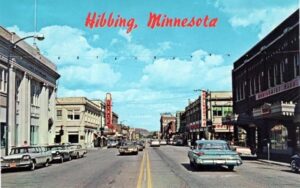 Westernseries
Westernseries
Hibbing, een plaatsje met zo’n tienduizend inwoners was tot bloei gekomen dankzij de omringende ijzerertsmijnen, maar in de jaren vijftig was de bloeitijd van het stadje al lang voorbij. Voor de opgroeiende jeugd was er niet veel te beleven. Er was een bioscoop, meer vermaak was er niet. In 1952 kon het gezin Zimmerman zich als eerste in Hibbing een televisie veroorloven. De jonge Bob bracht met zijn vrienden urenlang voor het toestel door.
Hij keek naar musicals en variety shows, maar zijn voorkeur ging uit naar westernseries als Wyatt Earrp, Kit Carson, Davey Crockett, maar vooral de serie Gunsmoke was zijn favoriet.
Vertraagd geweld
Van de serie Gunsmoke werden tussen 1955 en 1975 635 afleveringen gemaakt. Met kijkersogen van nu, ruim zestig jaar later, oogt de serie als uitermate braaf. In de volgens een vast stramien opgebouwde afleveringen werden de problemen in het keurige, burgerlijke plaatsje Dodge City op een beschaafde manier door Marshal Dillon opgelost. Daarbij vielen natuurlijk wel schoten en doden vielen er ook, maar zichtbaar bloed vloeide er nooit.
 Voor veel acteurs en regisseurs was de serie het startpunt van hun carrière. Bijvoorbeeld voor Dennis Weaver, die in de jaren zeventig de succesvolle serie McCloud maakte, en voor regisseur Sam Peckinpah. Peckinpah had al naam gemaakt als scenarioschrijver van tientallen afleveringen van de populaire westernserie Broken Arrow, maar voor Gunsmoke mocht hij het als regisseur proberen. Tussen 1955 en 1958 regisseerde hij elf afleveringen. Daarnaast maakte hij afleveringen van de westernseries The Rifleman en The Westerner. In de jaren zestig regisseerde hij de westerns Wichita, Major Dundee en Villa Rides. Bekendheid kreeg Peckinpah in 1969 als regisseur van de snoeiharde western The Wild Bunch, waarin hij alle film- en westernwetten overtrad door geweld vooral zo bloedig mogelijk in beeld te brengen, het liefst vertraagd vertoond en vanuit verschillende camerastandpunten gefilmd. In de jaren zeventig zou vertraagd geweld Peckinpahs handelsmerk blijken te zijn. Hij maakte onder meer films als Straw Dogs, The Getaway, Bring me the Head of Alfredo Garcia en Cross of Iron. In 1973 maakte hij zijn laatste western, Pat Garret and Billy the Kid, met in de hoofdrollen James Coburn en Kris Kristofferson.
Voor veel acteurs en regisseurs was de serie het startpunt van hun carrière. Bijvoorbeeld voor Dennis Weaver, die in de jaren zeventig de succesvolle serie McCloud maakte, en voor regisseur Sam Peckinpah. Peckinpah had al naam gemaakt als scenarioschrijver van tientallen afleveringen van de populaire westernserie Broken Arrow, maar voor Gunsmoke mocht hij het als regisseur proberen. Tussen 1955 en 1958 regisseerde hij elf afleveringen. Daarnaast maakte hij afleveringen van de westernseries The Rifleman en The Westerner. In de jaren zestig regisseerde hij de westerns Wichita, Major Dundee en Villa Rides. Bekendheid kreeg Peckinpah in 1969 als regisseur van de snoeiharde western The Wild Bunch, waarin hij alle film- en westernwetten overtrad door geweld vooral zo bloedig mogelijk in beeld te brengen, het liefst vertraagd vertoond en vanuit verschillende camerastandpunten gefilmd. In de jaren zeventig zou vertraagd geweld Peckinpahs handelsmerk blijken te zijn. Hij maakte onder meer films als Straw Dogs, The Getaway, Bring me the Head of Alfredo Garcia en Cross of Iron. In 1973 maakte hij zijn laatste western, Pat Garret and Billy the Kid, met in de hoofdrollen James Coburn en Kris Kristofferson.
Dylan, bevriend met Kristofferson, toonde interesse in een rol in de film en kreeg via de producer het script toegespeeld. Hij ging naar een voorstelling van The Wild Bunch en raakte zozeer enthousiast over de stijl van Peckinpah dat hij meteen erna de song Billy the Kid schreef. [2] Peckinpah was onder de indruk van het nummer en draaide het vrijwel continu.
Dylan mocht de soundtrack voor de film schrijven en kreeg zowaar een rolletje toebedeeld, als Alias, een hulpje van Billy the Kid.
Pseudoniemen
Alias. Hoe toepasselijk kan een naam zijn, want in de loop der jaren bediende Dylan zich van vele pseudoniemen. Hij noemde zich Elston Gunn toen hij in 1959 drie dagen lang deel uitmaakte van de begeleidingsgroep van vroege rocker Bobby Vee, totdat hij uit de band werd gezet omdat hij teveel aandacht van het publiek opeiste. Als Tedham Porterhouse speelde hij in 1964 harmonica op de elpee Ramblin’ Jack van Ramblin’ Jack Elliot. In datzelfde jaar speelde hij als Blind Boy Grunt enkele songs op een plaat van het folktijdschrift Broadside.
 Op de elpee The Blues Project. A Compendium of the Very Best on the Urban Blues Scene uit 1965, met o.a. Geoff Mudaur, Dave van Ronk en Eric von Schmidt, speelt hij piano als Bob Landy.[3] ‘To musicians, his piano playing is almost legend’, staat vermeld in de hoestekst. In 1972 verscheen hij als Robert Milkwood Thomas (!) op de plaat Somebody Else’s Troubles van Steve Goodman. Als Lucky Wilbury maakte hij deel uit van The Traveling Wilburys, de groep met George Harrison, Jeff Lynne, Roy Orbison en Tom Petty (1988), op hun tweede plaat heette hij Boo Wilbury (1990). Onder de naam Sergei Petrov schreef hij mee aan het scenario voor de film Masked and Anonymous (2003), waarin Dylan de rocklegende Jack Fate speelt. De afgelopen decennia produceerde hij zijn eigen platen onder de naam Jack Frost.
Op de elpee The Blues Project. A Compendium of the Very Best on the Urban Blues Scene uit 1965, met o.a. Geoff Mudaur, Dave van Ronk en Eric von Schmidt, speelt hij piano als Bob Landy.[3] ‘To musicians, his piano playing is almost legend’, staat vermeld in de hoestekst. In 1972 verscheen hij als Robert Milkwood Thomas (!) op de plaat Somebody Else’s Troubles van Steve Goodman. Als Lucky Wilbury maakte hij deel uit van The Traveling Wilburys, de groep met George Harrison, Jeff Lynne, Roy Orbison en Tom Petty (1988), op hun tweede plaat heette hij Boo Wilbury (1990). Onder de naam Sergei Petrov schreef hij mee aan het scenario voor de film Masked and Anonymous (2003), waarin Dylan de rocklegende Jack Fate speelt. De afgelopen decennia produceerde hij zijn eigen platen onder de naam Jack Frost.
 Speelfilms
Speelfilms
Bob Dylan is een filmliefhebber, dat is bekend. In 1956, na het zien van de film Giant met James Dean, wilde hij niets liever dan de nieuwe James Dean worden. Zijn rebellie uitte hij dan wel niet als filmster maar als folk- en rockartiest, zijn liefde voor film en met name voor western is in zijn songs terug te vinden.
Michael Gray, auteur van de indrukwekkende studie Song & Dance Man III. The Art of Bob Dylan (2000), was de eerste die merkte dat sommige passages in Dylansongs een opvallende overeenkomst vertoonden met dialogen of zinsneden uit speelfilms. Nauwgezette studie bracht aan het licht dat Dylan uit maar liefst 61 speelfilms citaten in songs heeft gebruikt, of verwijst naar filmtitels.[4] Negen daarvan zijn westerns, negentien titels – waarvan zes films met Humphrey Bogart – stammen uit de jaren veertig en vijftig, de periode van de film noir, bijvoorbeeld Casablana, To Have and Have Not, Shoot the Piano Player en Rear Window.
Enkele voorbeelden:
The Big Sleep (1946)
Bogart: ‘What’s wrong with you?’
Bacall: ‘Nothing you can’t fix’
Dylan in Seeing the Real You at Last:
‘At one time there was nothing wrong with me,
That you could not fix’
The Oklahoma Kid (1939)
Cagney: ‘You want to talk with me’
Bogart: ‘Go ahead and talk’
Dylan in Tight Connection on my Heart:
‘You want to talk to me
Go ahead and talk’
The Lusty Men (1952)
Mitchum: ‘Broken bottles, broken bones, everything is broken’
Dylan in Everything is Broken:
‘Broken bottles, broken plates,
Broken switches, broken gates
…
Everything is broken’
 In Bronco Billy (1980), een film over een rodeocowboy (eigenlijk een moderne western) zegt Clint Eastwood: ‘I’m looking for a woman who can ride like Annie Oakley and shoot like Belle Starr’.[5] In de song Seeing the Real You at Last (1985) zingt Dylan:
In Bronco Billy (1980), een film over een rodeocowboy (eigenlijk een moderne western) zegt Clint Eastwood: ‘I’m looking for a woman who can ride like Annie Oakley and shoot like Belle Starr’.[5] In de song Seeing the Real You at Last (1985) zingt Dylan:
‘When I met you baby
You didn’t show no visible scars.
You could ride like Annie Oakley
You could shoot like Belle Starr’
Het zou zo een citaat uit een film met Humphrey Bogart kunnen zijn.
Amerika
Meer nog dan Dylans soundtrack voor Pat Garrett and Billy the Kid ademt zijn achtste elpee John Wesley Harding de sfeer van een westernfilm uit. Titel en titelsong verwijzen niet alleen naar outlaw en gunfighter John Wesley Hardin (1853-1895), een song als The Ballad of Frankie Lee and Judas Priest roept beelden op van een westernstadje waar oplichters, mysterieuze godsdienstpredikers en zwervende outlaws de dienst uitmaken. Beelden zoals we die wel kennen uit klassieke westernfilms. Op de plaat heerst een geheimzinnige, soms onheilspellende sfeer, waarbij een Bijbels noodlot ieder moment lijkt te kunnen toeslaan. (De plaat bevat zo’n zestig verwijzingen naar de Bijbel, maar dat is een ander verhaal.)
De elpee dateert uit dezelfde periode (1968) waarin de beroemde Basement Tapes werden opgenomen. Dylan en The Band namen ruim honderd songs op in de kelder van het huis Big Pink in Woodstock. De in 1975 uitgebrachte plaat The Basement Tapes was hiervan slechts een magere selectie. De in 2014 uitgebrachte box The Basement Tapes Raw, The Bootleg Series Vol. 11 bood bijna alle opgenomen songs. De opnames lijken die van John Wesley Harding in een breder kader te plaatsen. Oude folk- en bluessongs en nieuwe songs van Dylan schetsen het beeld van een verdwenen Amerika, een negentiende eeuws gebied bevolkt door outlaws, hobo’s, landarbeiders, slaven en immigranten. Ballades uit de Appalachian Mountains, countrysongs, murderballads, kinderliedjes en gospelsongs vertellen de geschiedenis van dat verdwenen Amerika. The Basement Tapes weerspiegelen dat verleden en maken de luisteraar deelgenoot van die geschiedenis, alsof het filmbeelden zijn van een nog te maken epos over een mythisch, vrijwel vergeten land. Een land dat misschien alleen in de verbeelding bestaat. In die verbeelding kan Marshall Matt Dillon de orde handhaven.
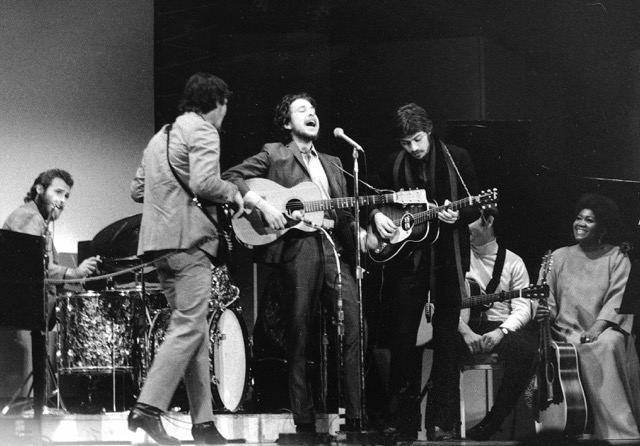 Noten
Noten
[1] Het interview met Dylan is te beluisteren op https://www.youtube.com/watch?v=483m8ADfG48
[2] Bob Dylan: Billy the Kid (audio) https://www.youtube.com/watch?v=ZEi83f_CEqM
[3] Geoff Mudaur, Downtown Blues, on piano Bob Landy (audio) https://www.youtube.com/watch?v=BCSsCK86ldc
[4] Movie quotes in Bob Dylan songs http://www.geocities.ws/linwood/cinema/Dylan-Film/
[5] Annie Oakley (1860-1926), legendarische Amerikaanse scherpschutster. Belle Starr (1848- 1889), outlaw, maakte deel uit van de bende van Jesse en Frank James.
De oudste bewegende beelden van Dylan (ca.1961)
